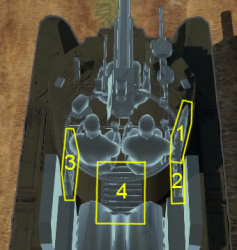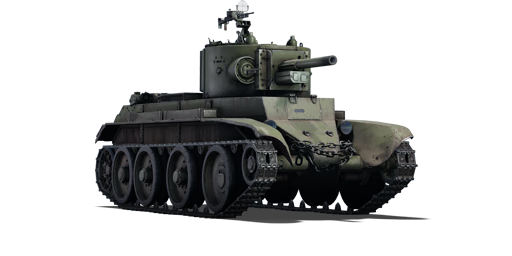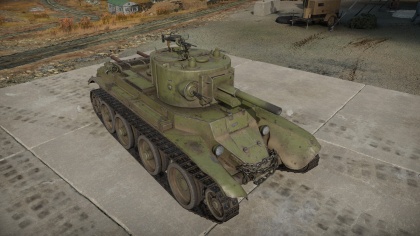Difference between revisions of "BT-7A (F-32)"
Colok76286 (talk | contribs) (→Survivability and armour: Added note) |
Colok76286 (talk | contribs) (→Mobility: Completed section) |
||
| Line 47: | Line 47: | ||
<!-- ''Write about the mobility of the ground vehicle. Estimate the specific power and manoeuvrability, as well as the maximum speed forwards and backwards.'' --> | <!-- ''Write about the mobility of the ground vehicle. Estimate the specific power and manoeuvrability, as well as the maximum speed forwards and backwards.'' --> | ||
| − | {{tankMobility|abMinHp= 620|rbMinHp= 354 | + | {{tankMobility|abMinHp= 620|rbMinHp= 354}} |
| + | |||
| + | As a light tank, the {{PAGENAME}} is very agile and has a very high top speed. Due to its high HP ratio, the acceleration is outstanding: 59 km/h in about 6 seconds off-road. The brakes are powerful and will make it skid rather than slow down when travelling at maximum speed. The reverse speed is good (-11 km/h): it will get you out of a dangerous situation quickly. While the {{PAGENAME}} lacks neutral steering, the turning speed on the spot is still good (8 km/h). It reaches 20 km/h when fording, 27 km/h when driving uphill with some speed built-up but only 13 km/h uphill from a stop. The narrow tracks will grant you a decent mobility on hard terrain (solid ground, roads) but poor mobility on soft terrain (mud, snow, sand), especially when changing direction as the tracks are long and close to one another. Light obstacles (fences and bushes) are not a problem but medium to large obstacles (posts, trees, concrete blocks and parked vehicles) will reduce your mobility: avoid them. | ||
== Armaments == | == Armaments == | ||
Revision as of 19:29, 19 September 2020
Contents
Description
The BT-7A (F-32) is a premium gift rank II Soviet light tank
with a battle rating of 3.7 (AB) and 4.0 (RB/SB). It was introduced during Update 1.89 "Imperial Navy" as one of the rewards for Operation H.E.A.T. It uses the same chassis as the BT-7 and as such, possesses the same armour, engine and crew layout but adds a new turret fitted with the F-32 76 mm gun.
The BT-7 (F-32) is a fast tank with thin armour for its BR. It should be used to flank and spot enemy tanks, taking advantage of its very high top speed. The armour is very well angled at certain points, however being as thin as it is, don't count on it to protect you very well. Your speed can be your best defence, so move fast and try to zig-zag a bit to make yourself a more difficult target for tanks farther away (not too much though, or you'll bleed off too much speed).
The BT-7 (F-32) uses the Christie suspension of the BT-7. Closer to a race-car than a tank, this lightning on tracks is fun to drive, but not particularly easy. With its high top speed and light weight, this tank will drift in turns. For maximum control in turns, reduce throttle beforehand and only tip/nudge the turn-keys. It needs some time to get used to, however, it does prepare you for the T-34s break-turns. It is important to note that the tank has impressive inertia when turning on the move, as such it will continue to turn even after you have released the command.
Off-road behaviour is good and the aforementioned drifts aren't as extreme as on city-roads. Top speed is not reduced as well, making the BT-7 (F-32) one of the fastest light tanks of its BR due to its very wide tracks. It has the best Power to Weight ratio when compared to the M24, Crusader Mk III, Sd.Kfz.234/2 and M5A1 but offers the second-worst reverse speed behind the Crusader.
The crew compartment is very small and inhabited by the driver, a loader and a gunner. The turret crew operate in a very small environment, so it is very rare that only one of them would die from a shot. "Not getting shot at" is the best advice for the crew to survive.
The BT-7 (F-32) tank's successor would be the famous T-34 medium tank, introduced in 1940, which would replace all of the Soviet fast tanks, infantry tanks, and medium tanks then in service.
General info
Survivability and armour
Armour type:
- Rolled homogeneous armour (hull, turret)
- Cast homogeneous armour (MG port)
| Armour | Front (Slope angle) | Sides | Rear | Roof |
|---|---|---|---|---|
| Hull | 15 mm (61°) Front glacis 20 mm (18°) Driver's hatch 20 mm (cylindrical) Lower hull |
20 mm Front 15 + 4 mm Rear |
10 mm (55°) Top 13 mm (16°) Bottom 13 mm (58°) Lower glacis |
10 mm 4 mm Engine vents |
| Turret | 15 mm (6-12°) Gun mantlet 15 mm (cylindrical) Turret front 15 mm MG port |
15mm Front 13mm Rear |
13mm Rear 15mm MG port |
10mm |
Notes
- Suspension wheels, tracks and torsion bars are 15 mm thick.
- Belly armour is 6 mm thick and mudguards are 4 mm thick.
- There is an inner wall (4 mm thick) acting as spaced armour along the flanks of the tanks and separating the engine compartment from the crew compartment.
Being lightly armoured, the BT-7A (F-32) is very vulnerable to nearby ammo rack detonations and bomb blasts.
Mobility
| Game Mode | Max Speed (km/h) | Weight (tons) | Engine power (horsepower) | Power-to-weight ratio (hp/ton) | |||
|---|---|---|---|---|---|---|---|
| Forward | Reverse | Stock | Upgraded | Stock | Upgraded | ||
| Arcade | 55 | 11 | 13.7 | 620 | 763 | 45.26 | 55.69 |
| Realistic | 50 | 10 | 354 | 400 | 25.84 | 29.2 | |
As a light tank, the BT-7A (F-32) is very agile and has a very high top speed. Due to its high HP ratio, the acceleration is outstanding: 59 km/h in about 6 seconds off-road. The brakes are powerful and will make it skid rather than slow down when travelling at maximum speed. The reverse speed is good (-11 km/h): it will get you out of a dangerous situation quickly. While the BT-7A (F-32) lacks neutral steering, the turning speed on the spot is still good (8 km/h). It reaches 20 km/h when fording, 27 km/h when driving uphill with some speed built-up but only 13 km/h uphill from a stop. The narrow tracks will grant you a decent mobility on hard terrain (solid ground, roads) but poor mobility on soft terrain (mud, snow, sand), especially when changing direction as the tracks are long and close to one another. Light obstacles (fences and bushes) are not a problem but medium to large obstacles (posts, trees, concrete blocks and parked vehicles) will reduce your mobility: avoid them.
Armaments
Main armament
| 76 mm F-32 | Turret rotation speed (°/s) | Reloading rate (seconds) | |||||||||||
|---|---|---|---|---|---|---|---|---|---|---|---|---|---|
| Mode | Capacity | Vertical | Horizontal | Stabilizer | Stock | Upgraded | Full | Expert | Aced | Stock | Full | Expert | Aced |
| Arcade | 50 | -6°/+25° | ±180° | N/A | 15.23 | 21.08 | __.__ | __.__ | 30.12 | 8.19 | _.__ | _.__ | 6.30 |
| Realistic | 9.52 | 11.2 | __.__ | __.__ | 16.0 | ||||||||
Ammunition
The available ammunition allows for engaging all types of targets:
- BR-350A (MD-5 fuze): APHEBC; an armour-piercing shell with high explosive mass that will destroy any tank it penetrates but has an average penetration power.
- BR-350B (MD-8 fuze): APHEBC; the same shell but with an increased penetration power at the cost of slightly less explosive filler.
- OF-350M: HE; useful for destroying open and lightly armoured vehicles.
- Sh-354T: Shrapnel; useful against vehicles that are resistant to the HE shells but too thinly armoured to trigger the fuzes of AP shells.
- D-350A: Smoke; useful to blind enemy vehicles that are too remote for you to disable so that you can progress towards objectives.
| Penetration statistics | |||||||
|---|---|---|---|---|---|---|---|
| Ammunition | Type of warhead |
Penetration @ 0° Angle of Attack (mm) | |||||
| 10 m | 100 m | 500 m | 1,000 m | 1,500 m | 2,000 m | ||
| BR-350A (MD-5 fuze) | APHEBC | 78 | 76 | 69 | 61 | 53 | 47 |
| BR-350B (MD-8 fuze) | APHEBC | 86 | 84 | 76 | 67 | 59 | 52 |
| OF-350M | HE | 10 | 10 | 10 | 10 | 10 | 10 |
| Sh-354T | Shrapnel | 37 | 35 | 29 | 25 | 20 | 17 |
| Shell details | |||||||||
|---|---|---|---|---|---|---|---|---|---|
| Ammunition | Type of warhead |
Velocity (m/s) |
Projectile Mass (kg) |
Fuse delay (m) |
Fuse sensitivity (mm) |
Explosive Mass (TNT equivalent) (g) |
Ricochet | ||
| 0% | 50% | 100% | |||||||
| BR-350A (MD-5 fuze) | APHEBC | 615 | 6.3 | 1.2 | 14 | 150 | 48° | 63° | 71° |
| BR-350B (MD-8 fuze) | APHEBC | 615 | 6.3 | 0.9 | 14 | 98.56 | 48° | 63° | 71° |
| OF-350M | HE | 615 | 6.2 | 0.05 | 0.1 | 621 | 79° | 80° | 81° |
| Sh-354T | Shrapnel | 615 | 6.2 | 0.5 | 8 | 85 | 62° | 69° | 73° |
| Smoke shell characteristics | ||||||
|---|---|---|---|---|---|---|
| Ammunition | Velocity (m/s) |
Projectile Mass (kg) |
Screen radius (m) |
Screen deploy time (s) |
Screen hold time (s) |
Explosive Mass (TNT equivalent) (g) |
| D-350A | 680 | 6.45 | 13 | 5 | 20 | 50 |
Ammo racks

Last updated: 1.101.0.75
| Full ammo |
1st rack empty |
2nd rack empty |
3rd rack empty |
4th rack empty |
Visual discrepancy |
|---|---|---|---|---|---|
| 50 | 47 (+3) | 39 (+11) | 31 (+19) | 1 (+49) | No |
Notes:
- Racks are modeled by sets of 2 shells. They disappear from the rack once all shells in the set have been loaded/fired.
- Turret and sides empty: 31 (+19)
Machine guns
| 7.62 mm DT | ||||
|---|---|---|---|---|
| Mount | Capacity (Belt) | Fire rate | Vertical | Horizontal |
| Coaxial | 1,890 (63) | 600 | N/A | N/A |
| Pintle mount | 1,890 (63) | 600 | -10°/+15° | ±180° |
The small caliber of the DT machine gun makes it largely ineffective against all armoured vehicles but the ones with an open compartment. It still can be used to ping targets as a rangefinding help. The clip capacity of the machine gun is quite poor, as it relies on a magazine of 63 bullets instead of a belt like similar machine guns from other nations.
Usage in battles
The BT-7 (F-32) is a light tank and should be played as such: try to surprise the enemy, take a shot before he can react and get to cover before his teammates send you to the hangar.
- Avoid rushing into a group of enemy head-on and exposing yourself for too long. Instead prioritise flanking and "sneak-peek" attacks.
- Stay away from intense enemy fire and common AA such as the Wirbelwind and R3 T20 FA-HS, which can easily shred through your paper-thin armour.
- Use your light tank's abilities to spot targets and help with teammates repairs.
Modules
| Tier | Mobility | Protection | Firepower | |||
|---|---|---|---|---|---|---|
| I | Tracks | Parts | Horizontal Drive | |||
| II | Suspension | Brake System | FPE | Adjustment of Fire | Airstrike | BR-350B (MD-8 fuze) |
| III | Filters | Crew Replenishment | Elevation Mechanism | |||
| IV | Transmission | Engine | Artillery Support | Improved optics | D-350A | |
| This is a premium vehicle: all modifications are unlocked on purchase | ||||||
Pros and cons
Pros:
- Very fast and nimble
- Excellent offroad capability
- Powerful engine and wide tracks make the BT-7 a good climber
- Excellent cannon with a good rate of fire and 150 g explosive shell
- Performs well even when up-tiered
- Slightly better gun depression than other 76mm counterparts (-6° over -5°)
- Features active scouting, repair assistance unlike other BT tanks
- Additional DT machine gun on pintle mount useful for spotting, attacking open-topped vehicles
Cons:
- Exposed tracks and suspensions are prone to be damaged
- Very thin armour and packed crew especially for 3.0
- Pretty large and difficult to hide
- Difficult to drive with precision - can slew on turns and bounces a lot after braking.
- More flat un-angled areas than BT-5
- Vulnerable to heavy machine gunfire
- Sometimes stalls on turns on soft terrain
History
Development
The success of the BT light tanks in Soviet service prompted additional upgrades and other developmental projects done on the design to increase its service life. The development led to the final model of the BT light tank series, the BT-7. The tank differed from the older BT-5 tank with a welded hull, redesigned hull front, and a new engine in the Model 1935 version. The Model 1937 version of the BT-7 added a redesigned turret that featured sloping armour.
The BT-7 (F32) is a modification of the BT-7 Artillery model sometimes called BT-7A. The artillery model took the design of the T-26-4 turret fitted with a KT-28 short-barrelled howitzer and mounted a 76 mm (3 in) CT short-barrelled howitzer. Due to the extra weight of the turret, the BT lost its ability to drive on the road wheels. 155 BT-7A model was created, 11 converted into command version and only a few were tested with a bigger 76 mm gun, the F-32 gun designed by the infamous Soviet weapon designer, Vasily Grabin.
The tanks saw limited service during the early stages of the Second World War, or "Great Patriotic War". The last reported action of the vehicles was in the Kiev district and Moscow in 1941. The tanks were also reportedly used in Manchuria against the Japanese.
Media
- Skins
- Videos
See also
- Vehicles equipped with the same chassis
- Vehicles equipped with the same gun
- Other vehicles of similar configuration and role
External links
| USSR light tanks | |
|---|---|
| T-26 | T-26 · T-26 (1st Gv.T.Br.) · T-26-4 · T-26E |
| BT | BT-5 · RBT-5 · BT-7 · BT-7 TD · BT-7M · BT-7A (F-32) |
| T-50 | T-126 · T-50 |
| T-70 | T-70 · T-80 |
| PT-76 | PT-76B · PT-76-57 · Object 906 |
| BMP | BMP-1 · BMP-2 · BMP-2M · BMP-3 |
| BMD | BMD-4 |
| 2S25 | 2S25 · 2S25M |
| Wheeled | BA-11 · BTR-80A |
| Other | T-60 · Object 685 · 2S38 |
| China | ▂Type 62 |
| USSR premium ground vehicles | |
|---|---|
| Light tanks | BA-11 · RBT-5 · BT-7A (F-32) · T-26 (1st Gv.T.Br.) · T-26E · T-126 · PT-76-57 · 2S38 |
| Medium tanks | T-34 (Prototype) · T-34 (1st Gv.T.Br.) · T-34E · T-34-57 (1943) · T-34-85E · T-34-100 · T-44-122 · TO-55 · T-55AM-1 · T-72AV (TURMS-T) · T-80UD · Т-80U-Е1 |
| ▂M3 Medium · ▂M4A2 · ▂T-III · ▂T-V · ▂МК-IX "Valentine" | |
| Heavy tanks | SMK · T-35 · ▂MK-II "Matilda" · KV-1E · KV-2 (1940) · KV-2 (ZiS-6) · KV-122 · KV-220 · IS-2 "Revenge" · Object 248 · IS-6 · T-10A |
| Tank destroyers | BM-8-24 · BM-13N · BM-31-12 |
| SU-57 · SU-76D · SU-76M (5th Gv.Kav.Corps) · SU-85A · SU-100Y · SU-122P · Object 120 | |
| SPAA | ▂Phòng không T-34 · ZUT-37 |





